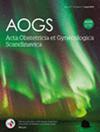The severity of second-degree perineal tears and dyspareunia during one year postpartum: A prospective cohort study
Abstract
Introduction
Childbirth-related injuries of the pelvic floor may impact women's sexual health with symptoms such as dyspareunia. A better understanding of dyspareunia based on tissue trauma severity in second-degree tears is needed. The primary aim of this study was to assess differences in dyspareunia according to the severity of perineal tears, with a focus on subcategories of second-degree tears at three and twelve months postpartum. The secondary aim was to assess the time to resumption of intercourse after birth according to the severity of second-degree tears.
Material and Methods
This single-center observational cohort study was conducted between January 2021 and July 2022. Women meeting the inclusion criteria were included during pregnancy. After birth, all perineal tears were classified according to RCOG recommendation, and second-degree tears were further subcategorized based on the percentage of damage to the perineum (2A, 2B, 2C). Dyspareunia and time to resumption of intercourse were collected through an electronic questionnaire at three and twelve months postpartum.
Results
Our study included 857 women; of them, 51.6% (n = 442) were primipara and 48.4% (n = 415) were multipara. The percentages of women reporting dyspareunia according to the degree of the tear at three months postpartum were as follows: no tear/first-degree tear 60%, 2A-tear 60%, 2B-tear 52%, 2C-tear 77%, and episiotomy 77%; and at twelve months postpartum: no tear/first-degree tear 52%, 2A-tear 50%, 2B-tear 40%, 2C-tear 69%, and episiotomy 64%. When comparing dyspareunia between the no tear/first-degree tear category and the second-degree subcategories, no statistically significant differences were found. Women in all second-degree subcategories resumed intercourse approximately 4.8 months postpartum, compared to 3.8 months postpartum for those with no tear or first-degree tear (p < 0.05).
Conclusions
There was no statistically significant association between the severity of second-degree tears and dyspareunia. The proportion of women reporting dyspareunia is noticeable for all perineal tear categories, with the highest rate among women with the most severe second-degree perineal tear. Women in all second-degree subcategories resumed intercourse approximately one month later than those with no tear or first-degree tear.


 求助内容:
求助内容: 应助结果提醒方式:
应助结果提醒方式:


